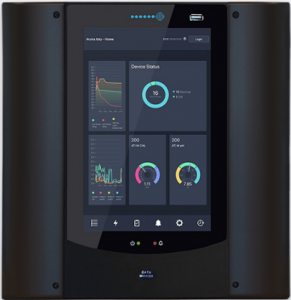

As part of the drive to move away from fossil fuels, the energy landscape is undergoing rapid and unprecedented levels of change. Over the past six years, accesstel’s turnkey integration and control of critical assets, has helped our customers deal with this change. Outcomes delivered include lower overall energy costs, improved operational efficiency, and enhanced energy-related operational reliability and resiliency.
The energy market is extremely complex with varying jurisdictions, regulations, approaches to encourage grid stability, and numerous key participants and utilities. There are, however, opportunities for organisations to participate to their advantage.
accesstel helped one customer use its existing standby generation capability to participate in the AEMO (Australian Energy Market Operator) RERT (Reliability and Emergency Reserve Trader) scheme.
In this case, at times when the grid was heavily loaded, the customer was paid for running its standby generation plants instead of taking power from the grid.
This netted this customer approximately $2M to $3M per year*, and delivered a project pay-back of one to two years*.
The overall benefits from this project include:
While the arrangements and returns for each organisation will be dependent on a wide range of factors, some customers have recouped over $200,000 in a single night from the solution that accesstel deployed.
Other initiatives accesstel have delivered, include Battery Energy Storage Systems (BESS), combined generation, Frequency Control Ancillary Services (FCAS), fuel cells, battery monitoring and control etc.
To learn more, see the complete report below.
*Note: an alternate commercial arrangement for this project could have further increased the revenue by up to 2.3 times and this change is now under consideration.
In recent times, it has become accepted that for the earth to remain habitable, fossil fuels will need to be rapidly phased out. For telecommunications providers, the hard commercial reality is that at the same time energy costs and usage are rising, network resiliency is also an increasingly important concern. The result is that a significant and complex transformation is required.
Underpinning the energy transformation are fundamental questions including:
To add yet another dimension, the use of Generative Artificial Intelligence (Generative AI) is becoming more prevalent. Generative AI will play a constructive role in managing the complexity of the energy transformation but will also have a significant impact on the amount of energy needed.
For example: By 2025, data centres are already expected to be the single largest consumer of energy globally, and some commentators are predicting that ChatGPT on its own will cause a further fivefold increase in data centre energy consumption.
Understanding the problem however is one thing, working out how to play a positive part in its implementation, is often a whole lot harder.
Six years ago, accesstel decided to get involved. We used our experience in automation, mediation, control, and project delivery to lead the necessary transformation.
The journey has been very rewarding, with the pace of change accelerating.
Initiatives that accesstel has played a leading role in include:
Many companies have standby generators to provide surety of supply during times of electricity grid outage. These generators can be a significant investment and are seldom heavily utilised.
accesstel worked with a key customer to re-engineer how their generators are activated, monitored, and deployed at times when the energy grid is heavily loaded. With the correct generation license and orchestration, when market prices are correct, these standby generators can be deployed to:
As a result of this activity, accesstel was able to facilitate our customers participation in the Australian Electricity Market Operator’s (AEMO) Reliability and Emergency Reserve Trader (RERT) program. (The RERT program supplies the energy market with additional capacity during peak demand)
As a result of participating in the RERT program, accesstel clients have generated returns of $200,000 or more in just one night.
This initiative has:
When undertaking this initiative, and particularly given the critical assets involved, many safeguards or critical features, must be designed into the solution. Some of the key ones include:
Battery Energy Storage Systems (BESS) are being deployed in a range of scenarios and offer some attractive possibilities. These include communities and councils seeking to maximise the financial return from rooftop solar deployments, to massive, large-scale deployments backing up peak loads on state-wide electricity grids.
accesstel has been involved in many BESS projects as regardless of the intended outcome, remote management, integration into existing systems and architectures, cyber security, and automation will be important parts of the final arrangement. This is where accesstel’s 20+ years of experience with critical assets, comes into play.
The deployments accesstel has done to-date, while designed to be used in anger, further tests and proves some of the emerging technologies. Learning how they can cost effectively, and best be used includes developing some real-world experience of:
BESS deployments can be very useful in providing alternating current (AC) power feeds while utilising batteries as a source of energy. A useful extension of this is where the BESS is utilised to also, directly feed the grid. This becomes viable because of the BESS systems relative ease at synchronising its frequency with that of the grid.
While BESS Systems can be based on a range of battery (and super capacitor) technologies and chemistries (and these will continue to change at a rapid pace), it is important to understand the strengths and weaknesses of each solution, along with the best practice safety protocols that apply. This includes the integration, monitoring, control, automation, and alarming that underpins peace of mind or project success.
While not always “sexy”, many real-world use cases for BESS systems involve incorporating them into existing infrastructure that has evolved over a lot of years. Our experience, when faced with these scenarios, allows us to maximise the outcome, while minimising the changes or cost of reworking previous architectures or investments.

Source: AEMO
Power grids need to be able to balance the total load against the total generation capacity. If there is a mismatch between the load and the generation capability, the frequency of the AC provided can deviate (from 50Hz) and in a worst-case scenario cause faults and or blackouts.
Managing the balance and generation capacity, has historically been relatively simple given an architecture involving a relatively low number of coal and gas plants feeding the grid.
Consider however the current energy transformation, where there are thousands of diverse generation sources, including little ones like household solar panels. Managing the balance between the grid load and generating capacity, becomes orders of magnitude more complex.
In response, the energy market operators have created “Frequency Control Ancillary Services” (FCAS) as a means of creating a fast injection of energy, or fast reduction in energy use, to balance supply and demand.
Under the FCAS scheme, an organisation with significant energy usage can generate additional revenue, if they manage their use of energy in alignment with the grid’s stability requirement.
For example: if the frequency of the grid is falling (i.e. the grid load higher than generation capacity), organisations set up for FCAS can be paid for taking some load off the grid (running for a period on batteries or another generation source for example).
accesstel, (along with a customer, energy utility and with some government sponsorship) has helped transform the customers energy and backup power arrangement to be able to play in the FCAS market.
Some of the high-level challenges considered and solved in this project include:
accesstel has validated that with suitable engineering and experience, it is possible to safely transform an organisation’s energy management environment to take advantage of AEMO’s FCAS structure. While many of the lessons learned will apply to other projects, there will always also be some degree of engineering required, which is dependent on the specifics associated with the organisation involved.
Batteries can play a key role in minimising energy costs and maximising network or operational resiliency, but to do so, their health and capacity needs to be accurately known. The health and capacity of the batteries can therefore be considered a prerequisite for many of the emerging energy strategies that organisations can deploy.
For many of accesstel’s customers, however, battery health approaches have been costly, of variable utility or validity, and historically therefore has not been widely utilised. Recognising the emerging importance of this gap, accesstel decided to take a fresh look at how this situation could be cost effectively improved.
The objectives for this initiative included:
Using in house development resources, accesstel is building an application, (accata®), which delivers the objectives detailed above.
Some sample screenshots from accata® are shown below
accata® has already been deployed in anger, at hundreds of live customer sites, and has been integrated as a key component of time of use, FCAS, and virtual power plant initiatives. Its accuracy, scope and utility are being continually enhanced (as a collaboration with one of accesstel’s key customers).
Key remotely initiated functions or methodologies underpinning the operation of the accata® battery health, capacity, and monitoring, are as follows:
accata® by accesstel delivers numerous benefits including:
Providing battery health and capacity data that:
The mediation, networking, and remote management capability that accesstel has deployed across generators, BESS, batteries, FCAS, etc. has also been utilised to remotely control and network air conditioning controllers. This is useful for the normal opex related monitoring and management reasons but is also applicable as an energy management strategy.
In many scenarios, air conditioning (and sometimes heating) results in significant energy costs. If an organisation is looking to reduce energy costs or capture revenue for assisting the grid when it is heavily loaded, reducing air conditioning (or heating) for a period can become a profitable strategy.
The use of this strategy depends on the organisation’s sensitivity to temperature fluctuations and the viability of approaches such as cooling early when a heat wave (high energy cost) is expected.
accesstel has integrated several air conditioning controllers and this facilitates them being used in concert with other remotely manageable energy resources, such as generators, BESS units, fuel cells etc.

Remote AC and monitoring controller
As with many of the industrial grade energy solutions that accesstel has developed, the combination of both central and edge processing plays an important role. It particularly facilitates safe out of band management, and other sophisticated site safeguards.
Orchestrating a range of energy related resources can assist an organisation to minimise its energy costs, and / or maximise its energy revenue. Air conditioning (and heating) plants can be included as one of these resources if planned carefully.
While diesel generators have many advantages including producing 20% fewer greenhouse gases than other common internal combustion engines, (hydrogen ICs excluded) they typically consume fossil fuels and still produce greenhouse gases.
Fuel cells can be simply seen as an emerging, greenhouse gas free alternative*.
*Note: this statement is only true if the fuel cell fuel is made using a green (renewable) process.
Currently this consideration is quite important as most of the hydrogen, methanol, and ammonia (the most common fuel cell fuels) produced globally is still being made from fossil fuels. These can be made however using renewable processes and there is quite a lot of focus on creating the facilities necessary to do so.
While the cost of a diesel generator and some of the current Proton Exchange Membrane (PEM) Fuel Cells can be roughly similar, the cost of the required fuel (H2 for example) can be three times more for the same electrical output. This disparity is expected to reduce as the hydrogen economy takes off and the new green production facilities come on-line.
As part of the evolution to the use of fuel cells, accesstel is participating in a pilot project deploying a small number of fuel cells as replacements for diesel standby generators.
Leveraging accesstel’s skills in mediation, automation, integration, and remote management, accesstel’s role in this project is to ensure that the fuel cells can be remotely and safely operated as required and will work seamlessly within an existing operations and energy orchestration environment.
accesstel sees this project as an exciting early stepping-stone towards the use of the new hydrogen economy.

Green Hydrogen Market Projection Precedenceresearch.com
A virtual power plant (VPP) is a network of individual distributed energy resources. Many of the initiatives that accesstel is involved in, such as those detailed above, can be seen as the building blocks required for creating VPP’s. VPP’s are a valuable part of the energy landscape because they can consist of smaller, widely distributed resources. As a result, they can often be quickly deployed and may not require significant changes to power network infrastructure (ie. no special transmission lines or significant upgrades may be required). These continue to be a costly and difficult issue for many mass solar and wind projects.
Leveraging its experience in with design, integration, remote management, control and rollout of the various elements that go towards making a VPP, accesstel is now working with its customers to realise VPP’s on a national scale. Click here to have a chat.

The future of telecommunications - how to increase your power reliability and reduce your carbon footprint.
Read more
What could the world look like as the telco and energy sectors converge?
Read more
How to take a pre-emptive approach to uninterrupted power supply and minimise disruption in any circumstance.
Read more